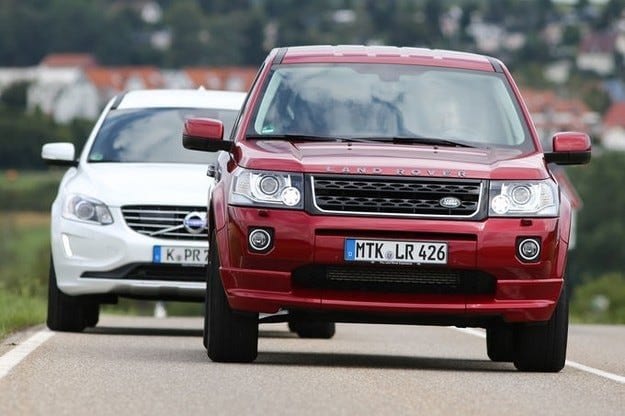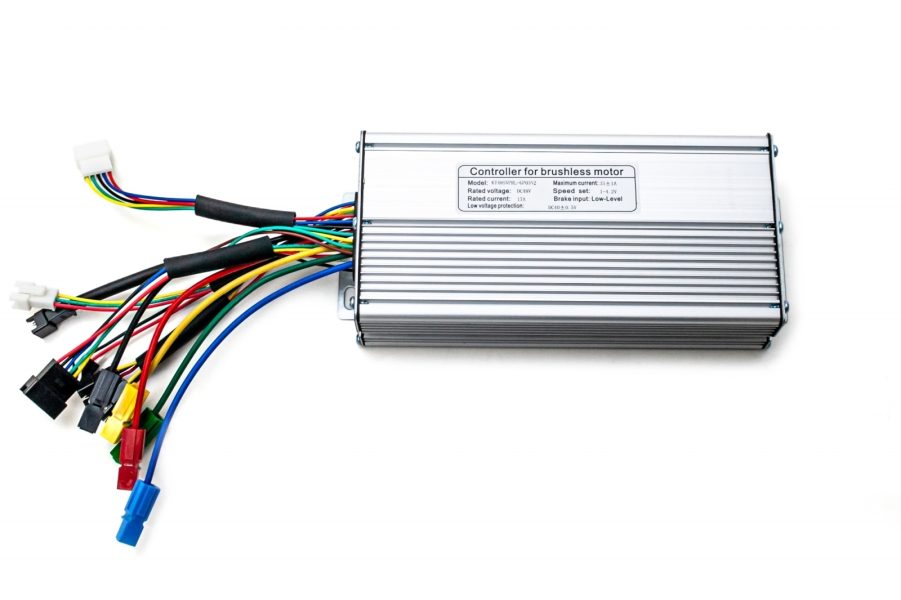
Test drive Land Rover Freelander and Volvo XC 60: Brothers of different blood

Yes it's true. The tough guy Rover Freelander and the elegant Volvo XC 60 are brothers in platform. Both models have recently been upgraded and are now equipped with the most powerful diesel engines, which shows that even such close relatives can be completely different.
Probably, no one dreamed of such a thing - then, with the rapid start of the Premier Auto Group (PAG). SUV models, the development of which began on time under the auspices of Ford, today rolled off the assembly lines of factories owned by the Indian group Tata (Land Rover) and the Chinese concern Geely (Volvo).
However, the Freelander and Volvo XC 60 remain siblings, because even after the update, they share the same platform, the so-called Ford C1. Other siblings in the expansive C1 family include the Focus and C-Max, as well as the Volvo V40 and Ford Transit Connect. You don't need to know all of these things; What's more interesting, along with the platform common to the two SUV models, is the dual-transmission system, which includes a Haldex clutch but has a completely different character.
Volvo XC 60 has a lower cost
The significantly larger of the two brothers, the Volvo XC 60, has a wheelbase of more than eleven centimeters and a length of almost 13 centimeters - almost the same difference as between two different classes. Beside it, the Freelander looks almost sleek, though it's a bit taller and wider than the Volvo XC 60. And heavier - because each of the C1's descendants weigh nearly two tons, especially since the two models come in such well-motorized and equipped versions. At 1866 kg, the Volvo XC 60 is exactly 69 kg lighter than its competitor.
After the upgrade last winter, Freelander has new lines of equipment; the instance in this comparison is SE Dynamic. Its standard equipment is so rich that it is difficult to think of anything that could be mentioned in the list of additional offers, except perhaps hard drive navigation for 3511 levs. Then the price of the version with a 2,2-liter diesel and 190 hp. .s. becomes BGN 88 and includes a six-speed automatic transmission, 011-inch wheels and two-tone leather upholstery. The Volvo XC 19 costs much less, 81 leva to be exact, when it is a five-cylinder 970-liter diesel unit with 60 hp. It also combines a dual transmission and an automatic in a not so rich Momentum package.
The test Volvo XC 60 is equipped with 18-inch wheels (17 inches as standard) and an adaptive chassis for a total of 4331 leva, which, in the name of correctness, are taken into account in the assessment. The more expensive but weaker Volvo is inferior to 27 hp. outperforms the Freelander's 190-hp four-cylinder engine, but the XC 60's five-cylinder engine makes that difference invisible – and brilliant. With a sympathetic but always distinct growl, he pulls the Swedish car with almost the same determination - at least according to subjective perceptions. Stopwatch detection is a few tenths higher, but they do not have a noticeable effect on everyday driving.
More importantly, the XC 60's drivetrain is behaving wildly. While when accelerating, Land Rover's automatic transmission sometimes hurriedly searches for the right gear and then rushes forward with a vengeance, the Volvo XC 60 saves downshifting and relies on the previously available maximum torque of 500 rpm (420 Nm at 1500 rpm). You can easily save on manual intervention with switch plates behind the steering wheel; Surcharge 341 leva for them is a completely optional expense.
The somewhat surprisingly larger five-cylinder engine shows less fuel consumption than the four-cylinder. In all disciplines, such as standard, minimum and average for the test, it registers the best values by a few tenths of a liter, which leads to an advantage in the Volvo XC 60 ratings.
On the road, the XC 60 demonstrates slightly better dynamics.
When assessing road behavior, the Volvo XC 60 again performs better. Both SUVs are not marvels of dynamic handling, but overall, the Volvo XC 60 turns more willingly and predictably than Land Rover, which often has no choice between clumsiness and hasty hyperactivity. This is partly due to the steering system, which reacts poorly to the road and reacts inharmoniously to the middle position of the steering wheel. In addition, the Landy's body movements are more pronounced due to the softer settings.
Both vehicles are extremely safe on the road because their electronic stability systems are alert and persistent in maintaining self-control. In the Freelander, they are slightly faster and sharper, which is not a mistake, given the pronounced tendency to wobble.
Both models have decent, if not great, brakes, and the Freelander admits one weakness: with heated brakes, the car takes 42 meters to stop at 100 mph – despite the 19-inch tires.
In addition, these tires are a big hurdle when Land Rover has to showcase its off-road talent. This is really a shame, because in this discipline he is vastly superior to his Swedish relative. The standard Terrain Response System, with its various drive modes, allows for feats in rough terrain that most Freelander customers are unlikely to resolve.
As befits this category of vehicle, both SUV models are good tractors. Therefore, it is even more incomprehensible that for both the towing device is only available as an accessory installed by the respective dealer. A Volvo XC 60 mobile towbar therefore costs 675 euros in Germany without installation and registration costs.
The Volvo XC 60 has a lot of talent
Overall, the Volvo XC 60 is slightly more practical than two cars, although it has less luggage space. Its rear seatbacks can be folded down to form a flat, easy-to-use surface, and a particularly useful cover separates the trunk when small loads need to be carried. Also, although for an additional fee (962 lev.), you can order an electric drive for the back cover - everything that is not available for Freelander.
In addition, the Briton is not very friendly towards his passengers. It is true that it takes on quite long bumps on the road, but short bumps constantly cause restless body movements, which, especially on the highway, turns out to be quite annoying and can be a consequence of large and wide wheels. The Volvo XC60 handles all of this better, at least with the adaptive suspension in Comfort mode. Then, even when fully loaded, the car does not lose its well-meaning manners; at the same time, both the front and rear seats are of better quality and more comfortable.
It also contributes to the solid leadership with which the Volvo XC 60 wins this duel between brothers.
Text: Heinrich Lingner
Conclusion
1.Volvo XC 60 D4 AWD
493 points
The XC 60 is the more balanced of the two cars. It wins over a more economical engine, richer safety equipment and better dynamic drivability. However, there is less space in the model.
2.Land Rover Freelander SD4
458 points
The Freelander has an exceptional position in this class of SUV models thanks to its generous interior space and a distinct talent for off-road driving. Therefore, his supporters are clearly ready to forgive his weaknesses in the field of dynamics.
technical details
| Model | Volvo XC 60 D4 AWD | Land Rover Freelander SD4 SE Dynamic |
| Engine and transmission | ||
| Number of cylinders / engine type: | 5-cylinder rows | 4-cylinder rows |
| Working volume: | 2400 cm³ | 2179 cm³ |
| Forced filling: | turbocharger | turbocharger |
| Power:: | 163 k.s. (120 kW) at 4000 rpm | 190 k.s. (140 kW) at 3500 rpm |
| Max. spin. moment: | 420 Nm at 1500 rpm | 420 Nm at 2000 rpm |
| Transmission of infection: | double with inclusion | double with inclusion |
| Transmission of infection: | 6-speed automatic | 6-speed automatic |
| Emission standard: | Euro 5 | Euro 5 |
| Shows CO2: | 169 g / km | 185 g / km |
| Fuel: | diesel | diesel |
| Price | ||
| Base Price: | 81 970 BGN | 88 011 BGN |
| Dimensions and weight | ||
| Wheelbase: | 2774 mm | 2660 mm |
| Front / rear track: | 1632 mm / 1586 mm | 1611 mm / 1624 mm |
| External dimensions | 4627 × 1891 × 1713 mm | 4500 × 1910 × 1740 mm |
| (Length × Width × Height): | ||
| Net weight (measured): | 1866 kg | 1935 kg |
| Useful product: | 639 kg | 570 kg |
| Permissible total weight: | 2505 kg | 2505 kg |
| Diam. turning: | 12,10 m | 11,30 m |
| Trailed (with brakes): | 2000 kg | 2000 kg |
| Body | ||
| View: | SUV | SUV |
| Doors / Seats: | 4/5 | 4/5 |
| Test Machine Tires | ||
| Tires (front / rear): | 235/60 R 18 V / 235/60 R 18 V | 235/55 R 19 V / 235/55 R 19 V |
| Wheels (front / rear): | 7,5 J x 17/7,5 J x 17 | 7,5 J x 17/7,5 J x 17 |
| Acceleration | ||
| 0-80 km / h: | 7,7 with | 6,6 with |
| 0-100 km / h: | 11,1 with | 10,1 with |
| 0-120 km / h: | 16,1 with | 15,3 with |
| 0-130 km / h: | 19 with | 18,6 with |
| 0-160 km / h: | 32,5 with | 33,7 with |
| 0-180 km / h: | 49,9 with | |
| 0-100 km / h (production data): | 10,9 with | 8,7 with |
| Maximum. speed (measured): | 190 km / h | 190 km / h |
| Maximum. speed (production data): | 190 km / h | 190 km / h |
| Braking distances | ||
| 100 km / h cold brakes empty: | 38,6 m | 39,8 m |
| 100 km / h cold brakes with load: | 38,9 m | 40,9 m |
| Fuel consumption | ||
| Consumption in the test l / 100 km: | 8,7 | 9,6 |
| min. (test route on ams): | 6,5 | 7,2 |
| maximum: | 10,9 | 11,7 |
| Consumption (l / 100 km ECE) production data: | 6,4 | 7 |
